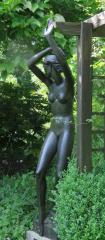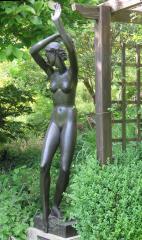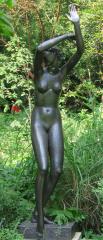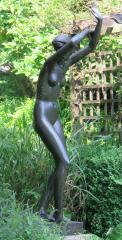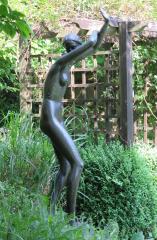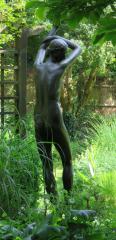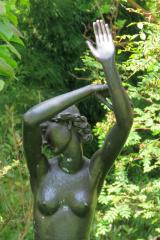Dyson-Smith statue ‘The Passing of the Wind’, Cheslyn Gardens, Watford
C. W. Dyson Smith: The Passing of the Wind.
What a pleasure to rediscover a statue which had vanished, with the suspicion of being sent into storage, perhaps never to reappear. The statue of The Passing of the Spirit, by C.W. Dyson-Smith, used to stand in a small pond by Watford Library, close to the war memorial, also with bronze sculpture. Some years ago, it was removed without explanation. And on a visit to Cheslyn Gardens, a beautiful semi-wild garden in the unlikely setting of central Watford which was left to the Council, I came across the reinstalled statue, this time in the most ideal of settings.
She is shown in the act of extending a foot forwards and downwards to the unseen water, her hands raised up, her face turned aside and one arm thrown across to veil her aspect from the observer – indeed, it is a characteristic of the statue that wherever direction you view her, you cannot satisfactorily see her full face. From directly in front, her forehead is eclipsed by her upper arm unless you go uncomfortably close (and the plants are in the way). If you move to your right, her left, to avoid that arm, her face is turning away from you. But when you move around to your right, then you can see her eyes but the arm covers her lower face. You can get a profile view only if you stand directly behind her, and even then her chin is somewhat covered by her shoulder and the top of her back. Overall then, this subtle pose gives her a secretiveness, a beguilement that adds interest and mystery to the statue.
She is nude, and physically of a type familiar from the 1930s, small-breasted and with narrow, boyish hips, her musculature reduced to a slender minimum, giving a simplicity of line while retaining enough femininity in the curvature of her limbs. It is her elongation that gives her slimness, for her waist is little thinner than her chest above, nor flares outward much below. Though her one foot reaches downward, and her opposite arm stretches upward, her torso is almost vertical and without angle around the waist: contrapunto she is not. And while her higher arm with its palm-out hand is forceful, her other arm, with a perfectly caught turn to the wrist as she rests her fingers lightly on her other forearm, is a study in graceful female gesture.
Oddly, the smooth minimalism on her front is not repeated on her back, where we clearly see her shoulder blades, and there is an emphasis on the inward line of her spine. There is detail too to her hair, which is twisted at the front, round to the sides and braided at the back.
Watford War Memorial, 1928: figures by Mary Pownall.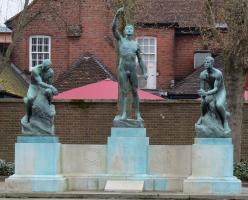
A few words on Watford. It is within Hertfordshire, but within the commuter belt for London, with both fast trains and the Metropolitan Underground. Though much is very modern and being continuously rebuilt, the core of the high street remains. At the top end, where the statue used to be, can be seen the Watford War Memorial, with three bronze male nudes, the work of the sculptor Mary Pownall. And in the centre of the High Street is St Mary’s Church, with excellent monuments, including grand reclining figures and kneelers.
Also in Hertfordshire: Hertford War Memorial // Monuments in nearby Watford Church or Aldenham Church // Tring Church // Aldbury Church // Abbots Langley Church // Wheathampstead Church
